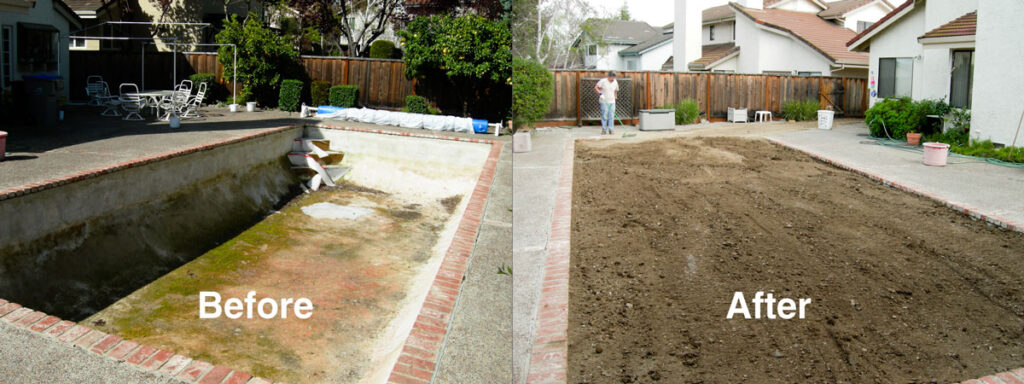As a pool owner you are all too aware of the high cost of maintaining a pool. You are no stranger to the ongoing electrical, chemical, and physical drain that is involved in pool maintenance. It may be that your pool has become dilapidated and you find that, for various reasons, you no longer use it at all. Relax, A-1 is here to help you weigh the pros and cons of pool removal and give you the tools you need to make an educated decision. Are you asking yourself the question, “Can I afford to demo my pool?” The real question is: Can you afford not to?
10 Reasons to remove your pool
- You can recover your money within two to four years of pool removal by eliminating pool maintenance costs.
- Significant Property Tax reduction
- Lower monthly utility costs
- Reduced Property Insurance fees
- Eliminate time consuming pool maintenance
- End the financial drain of pool supplies and expensive hardware
- Eliminate the need to retrofit your older pool for child protective purposes
- Repairing and resealing aging and dilapidated pools costs more than pool removal
- Pool leaks are not eco-friendly and can cause severe damage to house foundations
- Pool expenses remain high though the pool is seldom used.
Our Process
There are several different approaches to pool removal and backfill. Each one will have specific requirements that must be followed. This important information is located in the worksheet handout that is provided by the city where the work will be performed. A-1 will gladly provide you with this information as we walk you through the permit process. It is important that you have a general understanding of the procedures prior to making your decision. A-1 will walk you through the process from beginning to end and is committed to giving you quality and timely service.
Every pool is different but there are only three basic techniques for pool removal. The criteria for choosing the technique that is right for your pool will depend on city requirements; the type of pool you have; the desired finished product you would like to achieve; and staying within your budget.
Method 1 (The Cave-in Method)
- Utilities
- Drain Water
- Jackhammer drainage holes through bottom to city drainage and hole size requirements. Add an 8 inch layer of ¾ inch drain rock over holes if required.
- “Cave-in” the pool side walls to 12-24 inches below existing grade. Bend over or cut out steel reinforcement/rebar in cement spoils from side walls. The debris from the cave-in is then buried with the remaining pool shell and left in the pool bottom to act as a drainage bed for the new soil that is added.
With this technique special attention is given to filling up all voids and tightly packing the pool area with soil. This method tire packs the fill area. Note: this technique is accepted in most cities but may not be accepted in others.

Method 2
- Utilities
- Drain Water
- Jackhammer drainage holes through pool bottom of pool with placement of 8 inches of ¾ inch drain rock over holes if required.
- Truck in and tractor back enough clean fill dirt to fill pool to the natural sub-grade in preparation for your new landscape design.
With this technique, most often the entire pool shell and decking is left in place and the new landscape design is incorporated to fit the existing yard landscaping. This technique is for non-buildable and landscaping purposes only and offers no engineered compaction. This method tire packs the fill area. Note: this technique is not allowed in some cities.

Method 3
- Utilities
- Drain Water
- The entire pool shell, all rebar material and demolished concrete, Gunite, and pool equipment are removed from the site entirely, leaving only the raw-cut, excavated crater from the original pool excavation.
- Fill the remaining hole with compactable fill thus returning the yard to its pre-pool state.
Note: If you are planning to use the area for a new load bearing building or to dig a new modern swimming pool you will need to obtain a compaction report from a licensed soil engineer certifying that the area has been compacted 90 – 95% to according to city specifications.

